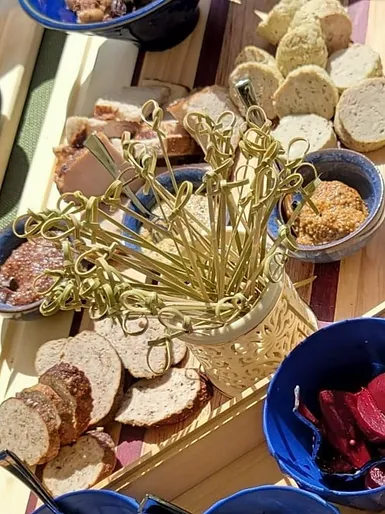Originally Published Oct 25, 2022
Das Kochbuch der Sabina Welserin, 1553
sausage (n.)article of food consisting of chopped or minced meat, seasoned and stuffed into the cleaned gut of an ox, sheep, or pig, and tied at regular intervals, mid-15c., sawsyge, sausige, from Old North French saussiche (Old French saussice, Modern French saucisse), from Vulgar Latin *salsica "sausage," from salsicus "seasoned with salt," from Latin salsus "salted," from past participle of Old Latin sallere "to salt," from sal (genitive salis) "salt" (from PIE root *sal- "salt").
This is another recipe that needs to be given proper attribution, it belongs to the Lady Aveline Grene, and it can be found at her website "Grene Boke: The Commonplace Boke of Aveline Grene".
I did make several changes to her recipe, the first being that I did not use liquid smoke. I smoked these with the smoked pork. Secondly, I did not use sausage casings. Instead, I used the saran wrap & simmer method that I use when I plan on serving sausages cold.
It is believe that it's origin came about as a way to preserve food in a convenient package. The first mention of sausage as a food can be traced to 'The Orya", a play performed in Ancient Greece that was written about 500 BC.
Sausages were also a favored food of the Romans, with three recipes found in Apicius’s De re coquinaria; botellus, blood sausage that includes egg yolks, lucanica, sausage made with pork, pork fat, pinenuts and spices, and lastly farcmina, a generic term meaning "to stuff".
Original Recipe
Weltt jr gútt prattwirst machen
So nempt 4 pfúnd schweinis vnnd 4 pfúnd rinderis, das
last klainhacken, nempt darnach 2 pfúnd speck darúnder
vnnd hackts anainander vnnd vngeferlich 3 seidlen wasser
giest daran, thiet aúch saltz, pfeffer daran, wie jrs geren est,
oder wan jr geren kreúter darin megt haben/ múgt jr nemen
ain wenig ain salua vnnd ain wenig maseron, so habt jr gút
brattwirst/.
Interpretation
If you would make good bratwurst
Take four pounds of pork and four pounds of beef and chop it finely. After that mix with it two pounds of bacon and chop it together and pour approximately one quart of water on it. Also add salt and pepper thereto, however you like to eat it, or if you would like to have some good herbs, you could take some sage and some marjoram, then you have good bratwurst.
Ingredients
1 pound (fatty) pork
1/2 pound (fatty) beef
1 tsp salt
3/4 tsp pepper
1/2 tsp marjoram
1/2 tsp thyme
1/4-1/2 tsp crushed caraway seed
1/2 tsp liquid smoke*
1/2-3/4 c water
sausage casing
Instructions
Grind pork and beef and mix together until uniform. Add the remaining ingredients and enough water to make the meat easy to stuff into your sausage casing. Cook in whatever manner you wish (baking, grilling, frying, boiling).
Sources
Coquinaria.Nl, 2022, https://coquinaria.nl/en/lucanian-sausages/. Accessed 17 Oct 2022.
"Das Kochbuch Der Sabina Welserin (C. 1553)". Justus-Liebig-Universität Gießen, 2022, https://www.uni-giessen.de/fbz/fb05/germanistik/absprache/sprachverwendung/gloning/tx/sawe.htm. Accessed 17 Oct 2022.
"Sausage | Etymology, Origin And Meaning Of Sausage By Etymonline". Etymonline.Com, 2022, https://www.etymonline.com/word/sausage. Accessed 17 Oct 2022.



